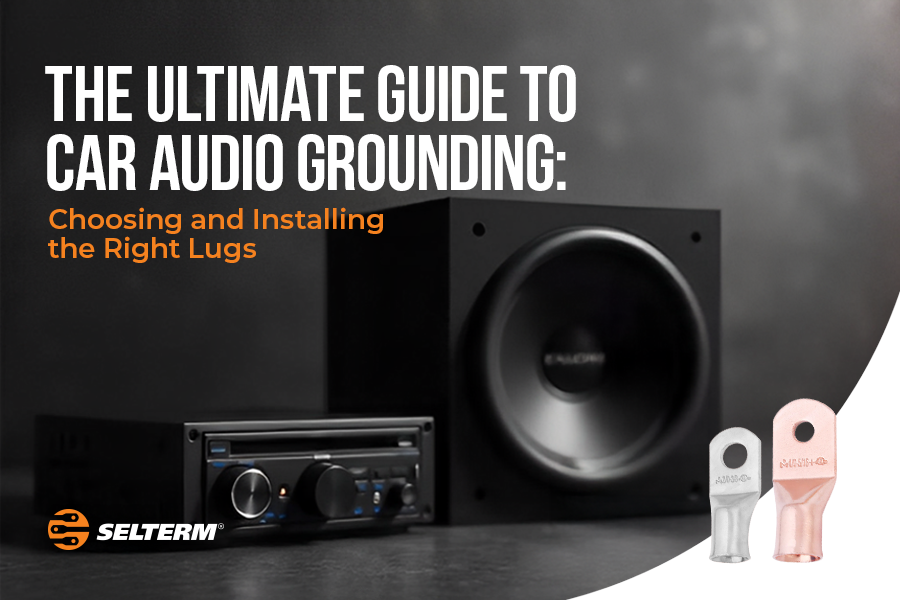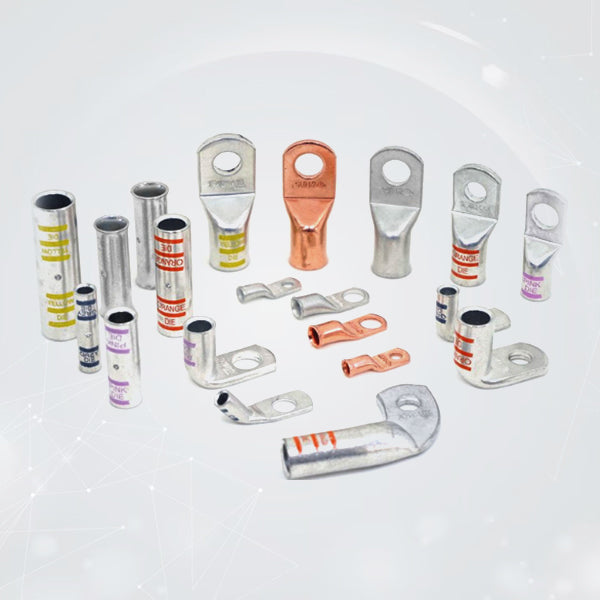
The Ultimate Guide to Car Audio Grounding: Choosing and Installing the Right Lugs
In the pursuit of achieving pristine audio quality within the mobile environment, car audio enthusiasts often focus on high-end speakers, amplifiers, and head units. However, a frequently overlooked yet critically important aspect of any car audio system is its grounding scheme. Proper grounding is not merely an afterthought; it's a fundamental requirement for minimizing electrical noise, ensuring signal clarity, and protecting sensitive audio components. The effectiveness of a car audio system's grounding relies heavily on the quality of the ground connections, and car audio ground lugs play a vital role in establishing these essential links. This guide provides a comprehensive exploration of car audio grounding, focusing on the selection and installation of appropriate lugs to achieve optimal audio performance.
The Importance of Proper Grounding in Car Audio Systems
The automotive electrical environment is inherently noisy. The vehicle's engine, alternator, and other electrical components generate a significant amount of electrical interference, which can infiltrate the audio system and degrade sound quality. Ground loops, a common problem in car audio systems, occur when there are multiple paths to ground with differing potentials, creating unwanted currents that manifest as hum or buzz in the audio signal. Proper grounding techniques are essential to mitigate these issues and ensure a clean and noise-free audio signal.
- Noise Reduction: Ground loops are a primary source of noise in car audio systems. These loops create voltage differences that introduce unwanted currents into the audio signal path, resulting in audible noise. Effective grounding strategies, utilizing car battery cable lugs to establish a single, low-resistance ground point, are crucial for minimizing ground loop interference and achieving a cleaner sound.
- Signal Clarity: A stable and low-resistance ground connection is essential for the accurate transmission of the audio signal. Fluctuations or inconsistencies in the ground potential can distort the signal, resulting in a loss of detail and clarity. By providing a consistent and reliable ground reference, car audio ground lugs help preserve the integrity of the audio signal, allowing for a more faithful reproduction of the original sound.
- Equipment Protection: Car audio components, such as amplifiers and head units, are sensitive to voltage fluctuations and electrical interference. Improper grounding can expose these components to damaging voltage spikes and transients, potentially leading to malfunction or premature failure. A well-designed grounding system, incorporating high-quality car audio battery lugs, provides a protective barrier, safeguarding the equipment and extending its lifespan.
- Safety: Beyond audio quality and equipment protection, proper grounding is also a critical safety consideration. A faulty ground connection can create a risk of electrical shock or other electrical hazards. A robust grounding system, correctly implemented with appropriate car audio ground lugs, ensures that the system operates safely, protecting both the occupants of the vehicle and the audio equipment itself.
Choosing the Right Lugs for Car Audio Grounding
Selecting the appropriate lugs for car audio grounding is a crucial step in establishing a reliable and effective grounding system. Several factors should be considered to ensure optimal performance and longevity.
1. Lug Material: The material of the lug plays a significant role in its conductivity and corrosion resistance.
- Copper Lugs: Copper is an excellent conductor of electricity and is a common material for audio ground lugs. Copper lugs provide a low-resistance connection, ensuring efficient current flow and minimizing signal loss.
- Tinned Copper Lugs: In the harsh automotive environment, where moisture and corrosion are prevalent, tinned copper lugs offer an added layer of protection. The tin coating provides enhanced corrosion resistance, preventing oxidation and ensuring a reliable connection over time.
2. Lug Size: The size of the lug must be compatible with the gauge of the ground wire. Using an undersized lug can restrict current flow and create a point of resistance, while an oversized lug may not provide a secure connection. It's essential to select a lug that matches the wire gauge to ensure optimal conductivity and mechanical stability.
3. Lug Type: The type of lug also influences its suitability for car audio grounding applications.
- Ring Terminals: Ring terminals are the most common type of lug used for grounding in car audio systems. Their closed-loop design provides a secure and reliable connection, ensuring that the lug remains in contact with the grounding point even under vibration or mechanical stress.
- Spade Terminals: While spade terminals can be used for grounding, they are generally less preferred than ring terminals due to their open design, which can be more susceptible to loosening or accidental disconnection.
4. Quality: Investing in high-quality car audio lugs is essential for ensuring a reliable and long-lasting ground connection. Cheap or poorly made lugs may be prone to corrosion, mechanical failure, or poor conductivity, all of which can compromise the performance of the audio system.
Installation Best Practices for Car Audio Ground Lugs
Proper installation of car audio ground lugs is just as important as selecting the right components. Following these best practices will help ensure a robust and effective grounding system.
1. Grounding Point Selection: The choice of grounding point is critical for minimizing noise and ensuring a stable ground reference.
- Clean, Bare Metal: The grounding point should be a clean, bare metal surface on the vehicle's chassis. Bare metal provides the best conductivity and ensures a low-resistance connection.
- Avoid Painted Surfaces: Grounding to painted surfaces is generally not recommended, as paint is an insulator and can impede conductivity. If a painted surface is unavoidable, the paint must be completely removed to expose the bare metal underneath.
- Chassis Ground: The vehicle's chassis is typically the most suitable grounding point, as it provides a large conductive surface area.
2. Surface Preparation: Proper surface preparation is essential for establishing a good electrical connection.
- Cleaning: Thoroughly clean the chosen grounding surface to remove any dirt, rust, or other contaminants. These substances can impede conductivity and increase resistance.
- Bare Metal Exposure: Use sandpaper or a wire brush to remove any paint, rust, or corrosion from the grounding surface, ensuring that the lug is in direct contact with bare metal.
3. Wire Preparation: Preparing the ground wire correctly is crucial for a secure and effective connection.
- Stripping: Carefully strip the insulation from the end of the ground wire to the appropriate length. Avoid stripping too much insulation, as this can expose excessive wire and increase the risk of shorts.
- Crimping: Crimp the car audio wire lugs securely to the ground wire using a crimping tool designed for the specific lug and wire size. A proper crimp creates a gas-tight seal, ensuring a low-resistance connection and preventing corrosion.
4. Secure Connection: Once the lug is crimped to the wire, it must be securely attached to the grounding point.
- Bolt and Nut: Use a bolt and nut to fasten the lug to the grounding surface. Ensure that the bolt and nut are made of a conductive material and are appropriately sized for the lug and the grounding point.
- Tightening: Tighten the connection securely to ensure good contact between the lug and the grounding surface. However, avoid overtightening, as this can damage the lug or the grounding surface.
5. Short Ground Wires: The length of the ground wire can impact the performance of the grounding system.
- Minimize Resistance: Keep ground wires as short as possible to minimize resistance. Longer wires offer more resistance, which can degrade signal quality.
- Reduce Ground Loops: Shorter ground wires can also help reduce the likelihood of ground loops by minimizing the potential for voltage differences between different ground points.
6. Star Grounding: In complex car audio systems with multiple components, a star grounding configuration can be beneficial.
- Single Point: Star grounding involves connecting all ground wires to a single central point. This minimizes ground loops by ensuring that all components share the same ground reference.
- Improved Isolation: Star grounding can also improve isolation between components, reducing the risk of noise and interference.
Common Grounding Issues and Solutions
Even with careful planning and installation, car audio systems can sometimes suffer from grounding-related problems. Here are some common issues and their solutions:
- Ground Loops: As mentioned earlier, ground loops are a frequent source of noise. If a ground loop persists, a ground loop isolator can be used to break the electrical connection between the ground paths, eliminating the unwanted current flow.
- Alternator Whine: Alternator whine, a high-pitched noise that varies with engine speed, is often caused by a poor ground connection. Ensure that the amplifier is properly grounded to a clean, bare metal surface and that the power and ground wires are routed separately to minimize interference.
- Engine Noise: Other types of engine noise can also infiltrate the audio system through the ground. Shielded audio cables can help reduce interference, and ensuring that the head unit is properly grounded is also essential.
Technical Details Recap
- Lug Material: Copper or Tinned Copper
- Lug Type: Ring Terminal
- Grounding Method: Star Grounding (Recommended)
Conclusion
Proper grounding is a cornerstone of high-quality car audio reproduction. By carefully selecting the right car audio ground lugs and adhering to best practices for installation, enthusiasts can minimize noise, ensure signal clarity, protect their equipment, and enhance the overall listening experience. A well-designed and executed grounding system is an investment in the performance and longevity of any car audio setup.

